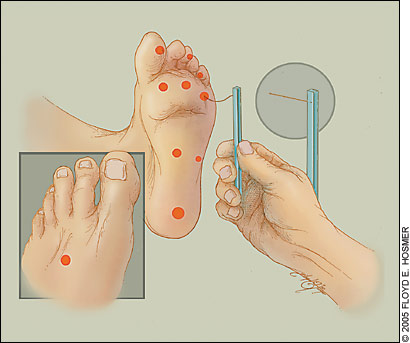2013 (205)
2014 (286)
2015 (207)
2016 (83)
2017 (254)
2020 (2)
2022 (1)
2023 (9)
2025 (1)


Daily foot care is essential for preventing complications of diabetic neuropathy (see patient information handout). Patients should be instructed to inspect their feet daily for dry or cracking skin, fissures, plantar callus formation, and signs of infection between the toes and around the toenails. Application of topical ointments to intertriginous areas should be avoided.
Properly fitted footwear is crucial. New shoes are a common cause of ulceration and should be broken in slowly. Patients also should avoid sources of possible trauma, such as walking barefoot, cutting nails incorrectly, and exposing their feet to hot objects or chemicals such as hydrogen peroxide, iodine, or astringents (e.g., witch hazel).
At each visit, the physician should examine the patient’s feet visually to detect evidence of neuropathy or early lesions. The ADA recommends a thorough annual foot examination by a health care professional for all patients with diabetes. The feet should be checked for skin breaks, red or callused areas, decreased or absent pedal pulses, and delayed capillary refilling, bony deformities, and protective sensation. Protective sensation is assessed by the 5.07 Semmes-Weinstein (10-g) nylon filament test (10-g monofilament test; Figure 1).
Once a patient has diabetic neuropathy, foot care becomes essential for preventing ulceration, infection, and amputation.26,27 A multidisciplinary team approach can reinforce preventive advice and help the patient develop and maintain good foot care habits.

Figure 1.
The 10-g monofilament test for diabetic neuropathy. Calluses must be reduced before testing is performed.
http://www.aafp.org/afp/2005/0601/p2123.html



